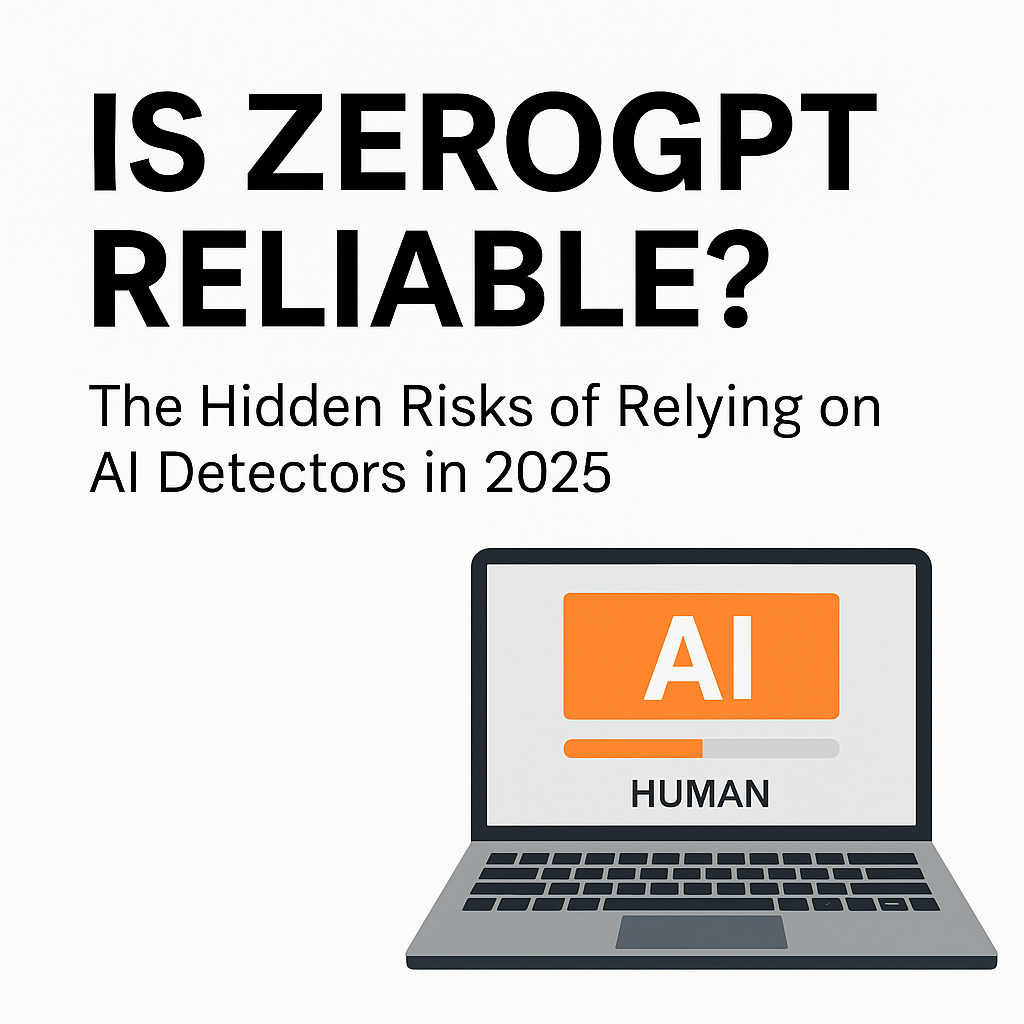Some tools promise precision but deliver false confidence. ZeroGPT is one of them.
If you’ve been wondering whether ZeroGPT can actually detect AI-generated content accurately, especially in high-stakes environments like education or legal documentation, you’re not alone. Here’s the blunt truth: while ZeroGPT functions as a basic classifier, its actual reliability is shaky at best and misleading at worst.
This article cuts through the marketing fog and lays bare the statistical flaws, operational blind spots, and ethical landmines that come with using ZeroGPT as your AI-detection solution.
What is ZeroGPT and how does it work?
ZeroGPT is a public AI detection tool launched in 2022. It aims to identify whether text is written by a human or generated by an AI. It provides both a percentage score and a binary verdict: AI or Human.
On the surface, that sounds helpful. Dig a little deeper though and you’ll discover that its architecture is built around stylometric signals like perplexity and burstiness. These refer to patterns in sentence length, word variation, and predictability.
But here’s the kicker. Those very patterns are now easily mimicked or manipulated by modern AI tools, or worse, by “humanizer” apps built specifically to fool detectors like ZeroGPT.
Can ZeroGPT detect ChatGPT and GPT-4 content reliably?
Not reliably. While ZeroGPT performs reasonably well on basic AI-generated content, it struggles significantly when faced with more advanced or edited outputs from tools like GPT-4 or Claude 3.
Why?
Because newer LLMs intentionally inject randomness into their responses (via temperature settings), blurring the line between machine and human output. When combined with simple paraphrasing or stylistic tweaking, even clearly AI-written content can fly under ZeroGPT’s radar.
In benchmark testing, ZeroGPT’s recall — meaning its ability to catch actual AI content — sits as low as 68.3%. That means 1 in 3 AI-written texts are wrongly classified as human. Not ideal if you’re counting on it to uphold academic or journalistic integrity.
What does ZeroGPT get right?
To its credit, ZeroGPT has been tuned to minimise false positives, meaning it is less likely to wrongly accuse a human of using AI. If you’re a teacher, HR rep, or manager trying to avoid falsely flagging an employee or student, that’s a safety net.
But there’s a trade-off. It misses a lot of actual AI writing.
This risk-averse strategy might protect reputations, but it severely limits the tool’s practical use. It’s the digital equivalent of an overly cautious referee. Great at not penalising the wrong player, but constantly letting fouls slide.
What are the biggest risks of using ZeroGPT in serious environments?
1. High False Negatives
If you’re trying to prevent AI use, ZeroGPT’s failure to detect paraphrased or “humanised” AI content makes it ineffective for enforcement.
2. Bias against formal writing
The algorithm often flags formal, grammatically flawless writing (the kind you’d expect from non-native English speakers or academic authors) as AI. That’s not just inaccurate, it’s discriminatory.
3. Evasion is easy
Third-party tools like HumanizeAI and WalterWrites openly market themselves as ZeroGPT evasion tools. And they work. This external breakdown
4. Legal risk from false positives
Wrongly accusing someone of academic dishonesty based on ZeroGPT’s flawed output could open institutions to serious legal exposure. There’s already growing concern around AI-detection tools violating students’ rights or due process.
How does ZeroGPT compare to other AI detectors?
| Tool | Accuracy | False Positives | False Negatives | Key Use Case |
| GPTZero | Up to 96.5% | Very low (0.9%) | Low | Academic and enterprise content |
| Originality.AI | 76–82% | Medium | Medium | SEO agencies, marketers |
| ZeroGPT | 64–73.8% | Low | High | Low-stakes screening only |
Should ZeroGPT be used in schools, universities, or compliance workflows?
In short: no, at least not on its own.
Expert reviews unanimously recommend that if ZeroGPT is used at all, it should be part of a broader, multi-factor verification process, not the sole determinant of authorship or misconduct.
Best practice includes:
- Version history checks (such as Google Docs edit logs)
- Oral defences or interviews
- Plagiarism plus AI tools used together
- Policy transparency, clearly outlining how detection tools are used and what thresholds trigger review
Some institutions now refuse to take action unless AI detection scores cross a high confidence threshold and are supported by contextual evidence. That’s a welcome shift and a smart risk-mitigation strategy.
What does the future of AI detection look like?
Stylometric detection is hitting its ceiling.
As AI-generated content becomes near-indistinguishable from human output, we’re shifting toward cryptographic watermarking (invisible codes embedded at generation) and chain-of-authorship protocols (such as timestamped drafts or document history logs).
Behaviourally, this is similar to shifting from reactive surveillance to proactive system design. Instead of policing output after the fact, we’re focusing on verifying the process behind it.
Think less: “Did a bot write this?”
And more: “Can we prove how this was created?”
Final thoughts: Are we using the wrong tool for the job?
Anyone who’s worked in education, journalism, or legal settings knows the stakes of getting authorship wrong. And while ZeroGPT feels like a techy safety net, its actual net has more holes than a backyard mozzie screen.
It might suit casual content screening — such as vetting blog contributions or checking bulk marketing copy — but trusting it to police academic honesty or legal reports? That’s a gamble with odds stacked against you.
What we need are smarter systems and better protocols, not just smarter algorithms.
And if you’re looking at broader AI compliance tools or content policies, this primer on AI reliability thresholds
FAQ
Is ZeroGPT free?
Yes, there’s a free version, but with limited feature depth and no result export options.
Can ZeroGPT catch ChatGPT or GPT-4 content?
Only some of it. Many AI-generated texts, especially paraphrased or “humanised” ones, go undetected.
What’s better than ZeroGPT?
Tools like GPTZero or Originality.AI offer higher accuracy and more advanced features, especially for mixed-source texts.
